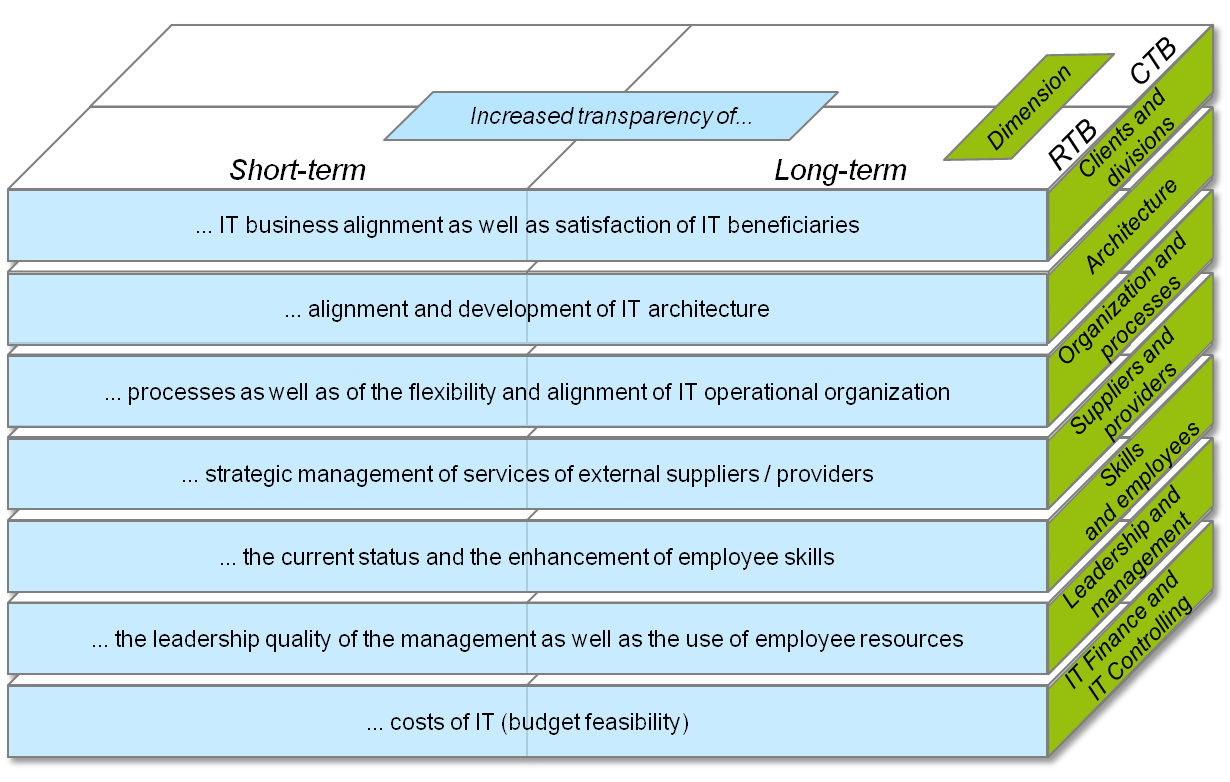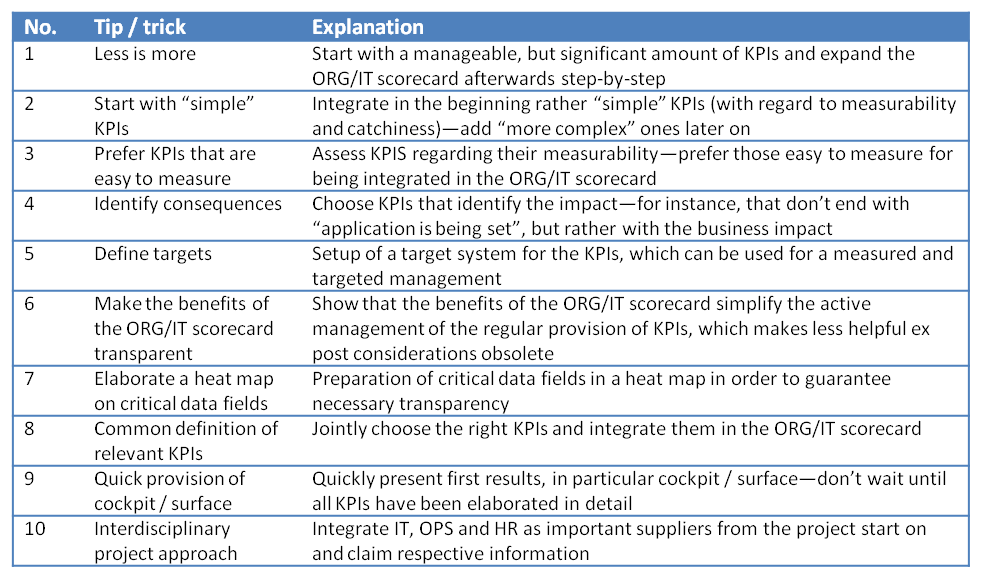Expectation of transparency and self-management towards ORG/IT
Issues such as IT cost pressure and value added have become an integral part of CIO agendas in a continuously difficult market environment for financial services providers. Due to reduced margins and rising regulatory requirements, the “run” side is suffering under cost pressure in order to achieve good contribution margins. At the same time, continuously increasing requirements necessitate more expenses in “change” in ever more shortened release cycles. In particular, since ORG/IT has become an active stakeholder and strives for a discussion on eye level, it is decisive that ORG/IT fulfills its tasks. There is a trend to choose such a positioning in order to ensure the sustainability of ORG/IT.
An important element is the establishment of an effective self-management, that means transparency of core key figures, identification of target deviations as well as derivation and consistent implementation of action impetus. Thus, the most important KPIs are to be identified and measured, targets are to be defined and the evolving ORG/IT scorecard is to be integrated in the strategic management processes. In addition to the top management of the ORG/IT scorecard, all operational processes for planning and cost management have to be established as well. However, we don’t want to go into detail, but rather focus on the success factors of developing and introducing an ORG/IT scorecard.
Balanced management with the IT scorecard
A complete coverage of all relevant dimensions and a balanced weighting is to be ensured for a successful strategic management of ORG/IT. Dimensions of the ORG/IT scorecard range from IT-based architecture and technology issues to “soft” leadership and employees issues in order to be able to create a discussion and communication platform (see figure 1).
The different financial and non-financial key figures, that are to be defined for these dimensions, present a holistic image of IT. A differentiation has to be made between short- / medium- and long-term periods. This guarantees that the right management incentives are derived. The short- and medium-term KPIs serve first and foremost for managing the target achievement within the fiscal year. The long-term KPIs, however, serve for managing the capacity to induce changes, be it by means of altering external influencing factors or strategic considerations of the bank. Above that, the KPIs are to be divided in the two fields of the value-added chain, CTB (change the bank) and RTB (run the bank). The CTB KPIs serve for ensuring the sustainability of the bank, the development of new products, solutions, processes and enhanced performance. The RTB KPIs, however, serve for ensuring the bank business by means of the existing services, solutions and processes of adequate quality, optimal cost efficiency and market-oriented delivery capacity.
An ORG/IT scorecard has to be tailored to the institution as needed. This means that the “significance” and “effort” are already to be considered when identifying the KPIs.
Hard facts vs. soft factors
While there are numerous KPIs and measurement procedures for the typical issues of IT Controlling, which are widely used in practice as well, soft factors are often underestimated. This leads to the fact that the existing KPIs are often underrepresented in the management tools. This comes as a surprise when considering the fact that good and highly qualified employees play a decisive role for the success of an ambitious ORG/IT work. Thus, it is recommendable to treat in particular the issues of “leadership” and “employees” as top priority when establishing a strategic management—even against resistance of controllers concentrating on figures and considering such key figures as esotericism. We wrote a special article for managing employees in ORG/IT, that goes into detail of methods and KPIS for sufficiently appreciating the “human factor”.
Less is more
The target concept of the ORG/IT scorecard is often very ambitious. A large amount of KPIs is considered “sound” in the conceptual design. At the latest during the implementation, it turns out that the goal has been too ambitious. Recording and especially permanently collecting KPIs is partly highly complex or even simply impossible.
In order to ensure the acceptance of the ORG/IT scorecard from the beginning on, it is more important to have results that are quickly to grasp than to insist on a complete coverage of all possible dimensions and perspectives. Another success factor is management support. For ensuring management support, an ORG/IT scorecard should include as a first step a management view with the top KPIs. This builds the foundation for piloting, on which the ORG/IT scorecard will be further developed step-by-step.
Use available information
We know from experience that there is already much information at hand—this is to be used first and foremost. First, transparency has to be created about potential sources, such as a ticket system in the user helpdesk, already existing reports from Controlling or other available standard reports, Then, quality and time-related availability of the information are to be assessed, before they are finally listed as sources for KPIs of the ORG/IT scorecard.
Using the already available information makes it possible to achieve quite quickly already visible success—the first pilot of an ORG/IT scorecard is set up with comparatively low efforts. In addition, it is important to rather rely on already familiar KPIs than complete strangers. Here as well, the following applies: “We’re all creatures of habit.” Sure, the “strangers” are also right and important, but due to reasons of acceptance which is to be achieved particularly quickly, they are rather part of downstream processes.
Integration of leaders
The KPIs and in particular the target values require a consistent acceptance of the leaders. It is indispensable to “get the leaders early on board”—not only with an invitation via e-mail, but within dialog-based events. This guarantees that the leaders can contribute their ideas and that reservations can be jointly discussed and eliminated. The goal is to create a common understanding of the definition of key figures as well as their measurement. This is the only way to ensure that they are always derived and interpreted in the same way.
The dimension of individual target agreements of the leaders is indispensable. If targets are defined, that don’t comply with the target values of the key figures of the ORG/IT scorecard, there won’t be any acceptance amongst the leaders for a sustainable management by using the ORG/IT scorecard. Thus, “thinking outside the box” during the conceptual design of the ORG/IT scorecard in order to detect such disruptive factors jeopardizing success is therefore not only voluntary, but obligatory.
Increase level of maturity
The concept of the ORG/IT scorecard creates a stable framework for the self-management of the unit. Its sustainability in the respective specific application context has been proven by means of a piloting. Thus, a first pragmatic “version 1.0” of the scorecard, that can be already used, has been established. This is not the end of developing the scorecard, but the further development is rather to be considered a continuous process. Without changing the basic structure, the common framework should be used to increase the maturity level of the solution into three directions step-by-step.
- Increase of coverage ratio within the topic areas: Based on the existing scorecard, it is to be evaluated for which topic areas there hasn’t been sufficient significance achieved yet. New KPIs are to be selected and integrated for these areas. Please make sure to focus on few KPIs and to not eliminate significant KPIs in order to not overwhelm the scorecard in the end.
- Increase of automation for identifying KPIs: Especially in piloting, several KPIs are still to be identified manually. Data collection and provision should be automated for proven KPIs step-by-step in order to ensure that it is up to date, to prevent errors and inconsistencies as well as cost-driving manual processes.
- Increase of “depth” by linking other KPIs: First, the time to market and the implementation of a solution according to the “less is more” principle is in the foreground. The “depth” of the scorecard is to be expanded for a further analysis of causes and for deriving specific recommended actions. This means that based on the top KPIs, a tree has to be built, that represents the KPIs in detail, which result in the values for the top management reporting.
An efficient alternative for ensuring a continuous improvement is the integration of a scorecard review in the annual planning process. This guarantees that—wherever necessary—target values are adjusted to the respective planning requirements, which in return creates target congruency.
Ten tips and tricks for successfully implementing an ORG/IT scorecard



